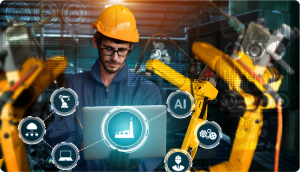
Why Equipment Failure Still Catches Manufacturers Off Guard
It’s a common and stressful moment in many factories when the machines suddenly stop, production halts, and no one knows what went wrong. Even though regular maintenance is done, unexpected breakdowns still happen and cause big disruptions.
So why does this keep happening?
Often, it’s because manufacturers miss small warning signs. Traditional maintenance methods don’t always catch the early clues that something’s about to go wrong. Small changes in how a machine runs, shifts in the environment, or the way a person operates the machine can all hint at future problems, but these signs are easy to overlook.
That’s where AI-powered equipment failure prediction makes a big difference. Instead of waiting for things to break, AI helps manufacturers stay one step ahead. By analyzing data from the machines in real time, AI can spot issues early and suggest the right time to fix them, before any damage is done.
In this blog, we’ll look at what companies often miss, how much unplanned breakdowns can cost, and how AI is changing the way maintenance is done.
What Manufacturing Firms Often Miss in Maintenance Monitoring
Even experienced maintenance teams can miss a few things, especially when relying on older methods. Here’s what often gets missed:
Sticking Only to a Fixed Schedule
Doing maintenance every few months is helpful, but it doesn’t always match how much a machine is actually used. Some machines work harder and wear out faster, while others don’t need as much attention. This can lead to either wasting time and money, or surprise breakdowns.
Not Using Sensor Data
Many machines have sensors that track things like temperature, pressure, or vibrations. But often, this data isn’t used properly or is spread across different systems. Without bringing it all together, it’s hard to know what’s really going on.
Ignoring Real-World Factors
Even if a machine looks fine, outside factors like dust, heat, humidity, or how people use it can affect its health. These things usually aren’t written down but can cause problems over time.
Not Linking Past Repairs with Current Data
Maintenance records and live machine data are often kept separate. But when you don’t connect them, you might miss important patterns, like a machine that keeps failing after the same type of repair.

The Cost of Unplanned Downtime
When a machine breaks down unexpectedly, it’s more than just a temporary hiccup; it can hit the business hard. Here’s what that really looks like:
- Production Halts: Even a few minutes of downtime can mean missing out on making thousands of products. That leads to delays, and customers don’t like waiting.
- Emergency Repairs: Fixing things in a hurry usually costs more than scheduled maintenance. Add in overtime pay and rush shipping for spare parts, and it gets expensive fast.
- Safety Risks: A machine that’s not working properly can be dangerous. Things like overheating, leaks, or sudden movements can cause accidents and put workers at risk.
- Supply Chain Issues: One broken machine can slow down the entire process, affecting vendors, delivery schedules, and customer orders down the line.
- Unhappy Customers: Delays and poor-quality products damage trust. In competitive industries, even one bad experience can push customers to go elsewhere.
Research suggests that unplanned downtime can cost manufacturers up to $260,000 per hour, depending on the industry. Imagine saving even a fraction of that by predicting failures in advance.

How AI Unlocks Predictive Power in Equipment Maintenance
AI has changed the game when it comes to equipment maintenance. Instead of waiting for things to go wrong, AI helps you spot issues early and fix them before they cause trouble. Here’s how it works:
Data Collection from Equipment and Environment
AI begins by collecting massive amounts of data not just from machines, but also from their environment. This includes:
- IoT sensor readings (temperature, pressure, vibration, energy consumption)
- PLC logs and SCADA systems
- Maintenance logs and repair history
- Environmental factors (humidity, dust levels, operator behavior)
What sets AI apart is its ability to correlate this diverse data in real time. It looks at your machines not in isolation but as part of a connected ecosystem.
Pattern Recognition and Anomaly Detection
Once the data flows in, machine learning models get to work. These models:
- Learn what “normal” operation looks like across all conditions
- Detect anomalies, patterns that deviate from the norm
- Recognize symptoms that typically occur before a failure (e.g., small spikes in temperature, irregular vibrations, slower response time)
This early detection is like having a technician with superhuman senses — able to detect issues days or even weeks before something breaks.
Predictive Maintenance Alerts & Integration
AI systems don’t just identify issues; they act on them.
- They estimate the probability of failure and the remaining useful life of equipment.
- They send real-time alerts to maintenance teams, guiding exactly when and what needs attention.
- They integrate seamlessly into existing systems like CMMS (Computerized Maintenance Management Systems) or ERP platforms, turning insights into actionable workflows.
The result? You only service machines when they actually need it — saving money, time, and hassle.
Enhancing Human Expertise
AI doesn’t replace human technicians; it empowers them. By providing deeper visibility and timely alerts, AI helps maintenance teams:
- Make more informed decisions
- Prioritize tasks based on actual risk
- Focus on solving root causes, not just symptoms
Think of AI as your smartest assistant, always watching, always analyzing, and always ready with data-backed advice.
Key Benefits and ROI for Manufacturing Firms
Adding AI to your maintenance process isn’t just about new technology; it’s a real boost for your business. Here’s how it helps:
- Reduced Unplanned Downtime: AI spots problems early, so you can fix them before they stop your machines and slow down production.
- Lower Maintenance Costs: You only repair things when it’s actually needed. That means no more wasting money on unnecessary checkups or emergency fixes.
- Extended Equipment Life: By keeping a close watch on equipment, AI helps prevent the kind of wear and tear that shortens a machine’s life.
- Improved Safety: Catching issues early means fewer accidents and a safer workplace for your team.
- Smarter Resource Allocation: Instead of guessing, AI helps you focus on the machines that really need attention.
- Clear ROI: Companies using predictive maintenance report up to 30% reduction in maintenance costs and 45% less downtime.
AI systems also offer built-in dashboards and reporting, helping you measure performance and prove value over time.
What About Data Security?
Reputable AI platforms or services use encrypted data transfers, role-based access control, and compliance with standards like ISO 27001 to ensure your information is protected.
Real-World Application Scenarios
AI-powered equipment failure prediction isn’t just futuristic talk; it’s already being used in real factories and workshops to solve everyday problems. Here are some real-world examples of how it’s helping in action:
- Motor Bearings: AI detects unusual vibrations or rising temperatures that signal bearing wear, long before a breakdown occurs.
- Hydraulic Leaks: AI detects unusual vibrations or rising temperatures that signal bearing wear, long before a breakdown happens.
- CNC Machines: AI tracks tool wear and alerts teams before it affects product quality — reducing scrap and rework.
- Air Compressors: By monitoring heat and load cycles, AI predicts overheating and prevents sudden compressor failure.
- HVAC Systems: AI analyzes airflow, energy use, and temperature to catch compressor problems early and keep systems running efficiently.
Conclusion: Shift from Reactive to Predictive Maintenance with AI
In today’s fast-paced manufacturing world, unexpected equipment failure isn’t just inconvenient; it’s expensive and disruptive. Relying on reactive maintenance (“fix it when it breaks”) just doesn’t cut it anymore.
The smarter way forward? Predictive maintenance powered by AI.
AI helps you stay ahead by spotting early warning signs, predicting potential failures, and connecting insights across your entire operation. Instead of scrambling to fix problems, you can prevent them from happening in the first place.
With AI on your side, you’ll benefit from:
- Less downtime and smoother operations
- Safer working conditions for your team
- Lower maintenance and repair costs
- Longer-lasting machines
- And most importantly, more satisfied customers
It’s time to stop reacting and start predicting, because the future of maintenance is not just smart, it’s proactive.
Say goodbye to breakdowns and hello to smarter maintenance. AI helps you prevent failures before they happen, and we’re here to help you get started. Contact us to learn how predictive maintenance fits into your operations.





